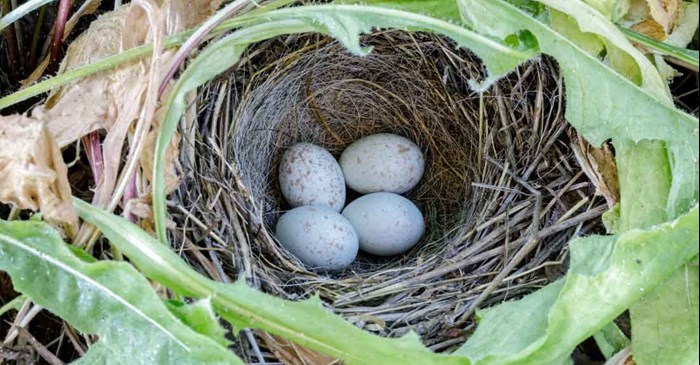Eggs and nests inspire joy and wonder in the spring for many bird-watchers. To give you more to appreciate about the miracle of birth and life that’s unfolding in backyards, woods and fields, let’s answer some common questions about those tiny eggs.
How are eggs formed?
When the ova (which we know as the yolk) is fertilized, it travels down the oviduct. There, it becomes surrounded first by a layer of proteins called the albumen (which comes from the Latin word for "white"), followed by that outer layer of calcium compounds, which harden once the egg is deposited into the nest. The female robin produces about one egg per day. Usually, birds don’t start incubating the eggs until they have a full clutch — that way, they’ll hatch around the same time.
Why are bird eggs oval?
Next time you make omelets, hold the egg in the palm of your hand and squeeze. (But take off any rings first.) Unless you apply pressure to one particular spot, it shouldn’t break or crack. Then, squeeze as you apply pressure to the top and the bottom. No breakage, right? Mother Nature is quite the engineer. Eggs have a three-dimensional arch structure. What arches do is distribute the weight evenly, giving it the strength to stay intact even when mom and dad are sitting on them. At the same time, eggs are delicate enough to shatter and break when pressure is directly applied to the egg. So a teeny tiny baby weighing no more than a nickel can punch its way out with its little beak.
The eggshell itself is semipermeable, which allows the exchange of oxygen and carbon dioxide to pass through the pores. At the same time, there’s a thin layer that keeps out dust and bacteria.
Why are some eggs blue?
Songbird eggs come in different colors, depending on species. Some are blue, brown or speckled. As a rule, brown eggs with speckles are common in birds that nest near the ground, because they camouflage with their surroundings. Others are blue, which reflects ultraviolet radiation. Others have ultraviolet colors, which are visible to birds because their eyes have the receptors to see them.
Our neighborhood songbirds need extra energy during nesting season, which is a great reason to keep those feeders well-filled. Lyric Fruit and Nut Mix is packed with high-quality seeds, fruit and nuts to give colorful songbirds the fuel they need this spring.
